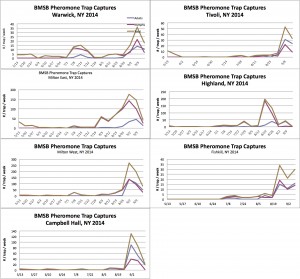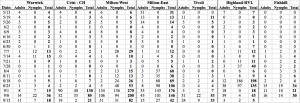
The attraction of the insect to aggregation pheromones allows for these trapping tools to be used to both monitor the insect to determine presence and populations density. The adult will continue to contribute to very high numbers in the orchard if left unmanaged, primarily along the wooded edges of apple blocks, during the month of September. In previous years we have seen increasing levels of fruit feeding injury within the first 90′ from the orchard edge near woodlands.
Traps placed along the wooded perimeter of HV orchards in 6 of 7 of our monitored sites, have trap captures at or slightly above the ‘Provisional Trap Threshold’ of 10 adults per trap per week. Developed by Tracy Leskey’s team at USDA ARS-W.V., the threshold will provide growers with a scientific basis for management, one that we are testing as an action threshold this season.

Adult movement to tree fruit will continue over the next two months. As fruit is harvested, the BMSB will be drawn to remaining fruit with very high concentrations possible later into the season, especially on varieties such as Empire, Red Delicious, Golden Delicious, Cameo, Fuji, GoldRush and Pink Lady. The adults will be moving in and out of orchards, seeking host food sources to stock up on reserves to take them through the winter and at the same time, moving to urban structures and forest trees (upper canopy of dead trees with ‘flaking’ bark) as overwintering sites. Drying and drought conditions will likely increasing fruit injury from BMSB.
Trap Capture and Scouting Threshold: Throughout the Hudson Valley there is a large disparity between orchards of both presence and abundance of BMSB. In some sites management will need to intensify until the last variety is completely harvested, while in other sites BMSB will not be found in traps in numbers that warrant control measures. In all sites scouting should also continue through the remainder of harvest.
Using the ‘Provisional Trap Threshold’, if BMSB adult captures exceed 10/ trap per week, or if the insect is observed on the tree, using 1 BMSB per 100 feet of perimeter orchard linear row, applications for management of BMSB should be made. Employ the first available window using one of the most effective insecticides that will best fit your harvest schedule.

The list of the most effective insecticides for BMSB management is found using this link. NYS labeled insecticides effective for use against the BMSB are available in four major classes including pre-mix formulations.
Thionex and Bifenthrin are the most effective insecticides for use against the BMSB. However, at this point in the season early blocks should be managed using Bifenthrin, Danitol and Lannate (14d PHI), with later harvested blocks employing Thionex (21d PHI). Blocks being harvested next week should use Leverage 360 (7d PHI). Boarder applications to cover most vulnerable blocks should be considered.


